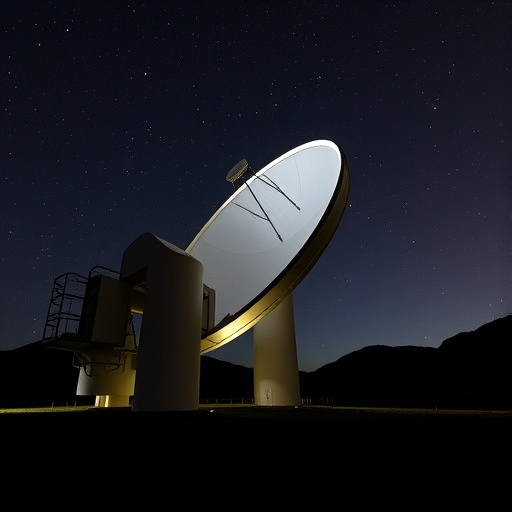
view more
Credit: Damien Jemison, Giant Magellan Telescope – GMTO Corporation
PASADENA, CA, and CAMBRIDGE, MA – September 30, 2025 – The Giant Magellan Telescope today announced that the Massachusetts Institute of Technology has joined its international consortium, constructing the $2.6 billion observatory in Chile. The Institute’s participation is enabled by a transformational gift to MIT from philanthropists Phillip (Terry) Ragon ’72 and Susan Ragon.
“MIT is a world-renowned academic institution whose excellence in science, engineering, and discovery makes it a natural partner for us,” said Dr. Robert Shelton, President of the Giant Magellan Telescope. “MIT brings critical expertise and momentum at a time when global leadership in astronomy hangs in the balance. With MIT, we are not just adding a partner; we are accelerating a shared vision for the future and reinforcing the United States’ position at the forefront of science.”
The private research university becomes the 16th member of the international consortium advancing the Giant Magellan Telescope and the 10th based in the United States. This distinguished group includes the University of Arizona, Carnegie Institution for Science, The University of Texas at Austin, Korea Astronomy and Space Science Institute, University of Chicago, São Paulo Research Foundation (FAPESP), Texas A&M University, Northwestern University, Harvard University, Astronomy Australia Ltd., Australian National University, Smithsonian Institution, Weizmann Institute of Science, Academia Sinica Institute of Astronomy and Astrophysics, and Arizona State University.
Together, the consortium brings more than 600 years of combined experience in building the world’s most powerful telescopes and has invested $1 billion in the Giant Magellan Telescope — the largest-ever private investment in ground-based astronomy. The Giant Magellan Telescope is already 40% under construction, with major components being designed and manufactured across 36 U.S. states.
“MIT is honored to join the consortium and participate in this exceptional scientific endeavor,” said Ian A. Waitz, MIT’s vice president for research. “The Giant Magellan Telescope will bring tremendous new capabilities to MIT astronomy and to U.S. leadership in fundamental science. The construction of this uniquely powerful telescope represents a vital private and public investment in scientific excellence for decades to come.”
MIT brings to the consortium powerful scientific capabilities and a legacy of astronomical excellence. MIT’s Departments of Physics and Earth, Atmospheric and Planetary Sciences, and the MIT Kavli Institute for Astrophysics and Space Research are internationally recognized for research in exoplanets, cosmology, and environments of extreme gravity such as black holes and compact binary stars. MIT’s involvement will strengthen the Giant Magellan Telescope’s unique capabilities in high-resolution spectroscopy, adaptive optics, and the search for life beyond Earth. It also deepens a long-standing scientific relationship: MIT is already a partner in the existing twin Magellan Telescopes at Las Campanas Observatory in Chile — one of the most scientifically valuable observing sites on Earth and the same site where the Giant Magellan Telescope is now under construction.
“Since Galileo’s first spyglass, the world’s largest telescope has doubled in aperture every 40 to 50 years,” said Robert A. Simcoe, Director of the MIT Kavli Institute for Astrophysics and Space Research, and the Francis L. Friedman Professor of Physics. “Each generation’s leading instruments have resolved important scientific questions of the day and then surprised their builders with new discoveries not yet even imagined, helping humans understand our place in the universe. Together with the Giant Magellan Telescope, MIT is helping to realize our generation’s contribution to this lineage, consistent with our mission to advance the frontier of fundamental science by undertaking the most audacious and advanced engineering challenges.”
MIT’s support comes at a pivotal time for the observatory. In June 2025, the National Science Foundation (NSF) advanced the Giant Magellan Telescope into its Final Design Phase, one of the final steps before it becomes eligible for federal construction funding. To demonstrate readiness and a strong commitment to U.S. leadership, the consortium offered to privately fund this phase, which is traditionally supported by the NSF. MIT’s investment is an integral part of the national strategy to secure U.S. access to the next generation of research facilities known as “extremely large telescopes,” which will have five times the light-collecting area and up to 200 times the power of today’s observatories.
The Giant Magellan Telescope is a core partner in the U.S. Extremely Large Telescope Program, the nation’s top priority in astronomy. The National Academies’ Astro2020 Decadal Survey called the program “absolutely essential if the United States is to maintain a position as a leader in ground-based astronomy.” This long-term strategy also includes the recently commissioned Vera C. Rubin Observatory in Chile. Rubin is scanning the sky to detect rare, fast-changing cosmic events, while the Giant Magellan Telescope will provide the sensitivity, resolution, and spectroscopic instruments needed to study them in detail. Together, these Southern Hemisphere observatories will give U.S. scientists the tools they need to lead 21st-century astrophysics.
“Without direct access to the Giant Magellan Telescope the United States risks falling behind in fundamental astronomy, as Rubin’s most transformational discoveries will be utilized by other nations with access to their own ‘extremely large telescopes’ under development,” said Walter Massey, Board Chair of the Giant Magellan Telescope.
MIT’s participation brings the U.S. a step closer to completing the promise of this powerful new observatory on a globally competitive timeline. With federal construction funding, it is expected that the observatory could reach 90% completion in less than two years and become operational by the 2030s.
Ryan Kallabis
GMTO Corporation
rkallabis@gmto.org
Office: 626-204-0554
Keywords
bu içeriği en az 2000 kelime olacak şekilde ve alt başlıklar ve madde içermiyecek şekilde ünlü bir science magazine için İngilizce olarak yeniden yaz. Teknik açıklamalar içersin ve viral olacak şekilde İngilizce yaz. Haber dışında başka bir şey içermesin. Haber içerisinde en az 12 paragraf ve her bir paragrafta da en az 50 kelime olsun. Cevapta sadece haber olsun. Ayrıca haberi yazdıktan sonra içerikten yararlanarak aşağıdaki başlıkların bilgisi var ise haberin altında doldur. Eğer yoksa bilgisi ilgili kısmı yazma.:
Subject of Research:
Article Title:
News Publication Date:
Web References:
References:
Image Credits:
Keywords



